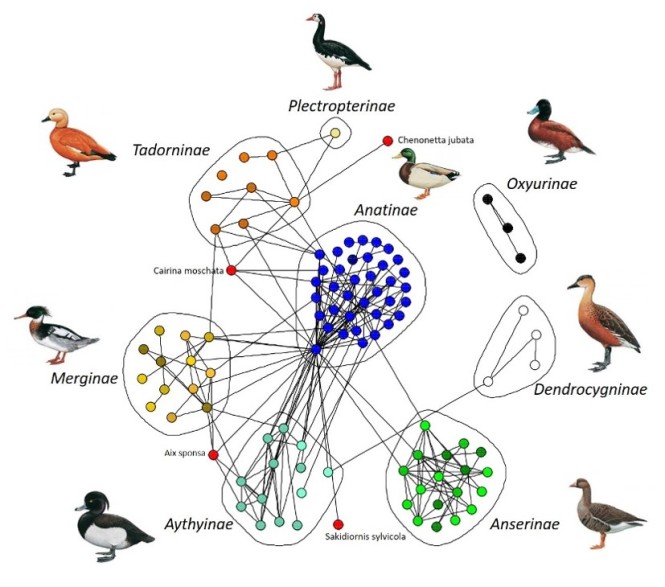The genetic similarity between members of this complex is mainly due to ancestral variation and ancient gene flow.
The Mallard (Anas platyrhynchos) is the king of hybrids. This duck species has hybridized with at least 40 different species. Specifically, it regularly interbreeds with its closely related monochromatic (i.e. males and females have the same color) cousins, such the Mottled Duck (A. fulvigula), the Black Duck (A. rubripes) and the Spot-billed Duck (A. zonorhyncha). This extensive hybridization has raised conservationists warning flags. Is the Mallard driving these species to extinction by hybridization? A recent study in the journal Molecular Ecology explored the Mallard complex to answer this question.

The Mallard hybridizes with numerous other duck species. © Richard Bartz | Wikimedia Commons
The Mallard Complex
Philip Lavrestsky and his colleagues sequenced the DNA of five members from the Mallard complex that occur in North America: the Mallard (obviously), the American Black Duck, the Mexican Duck (A. diazi), the Florida Mottled Duck and the West Gulf Coast Mottled Duck (for more information about population structure in the Mottled Duck you can read this blog post). Although these species are morphologically clearly distinct, it has been proven difficult – if not impossible – to distinguish between them genetically.
The genetic similarity of these duck species could be due to two processes: extensive gene flow through hybridization or retention of ancestral genetic variation (the technical term is incomplete lineage sorting). My money would be on the first possibility, but I am biased when it comes to avian hybrids…

The monochromatic members of the Mallard complex: the Mexican Duck (topleft, © Gary L. Clark), the Mottled Duck (topright, © Dick Daniels) and the American Black Duck (bottom, © Dick Daniels)
Patterns of Gene Flow
Using a large genetic data set (with over 3000 loci), the researchers were able to assign individuals to their respective taxonomic groups. They also inferred gene flow between particular species, but the results varied depending on which genetic variants were analyzed. In general, they found the following patterns of gene flow (I added information about the variants that supported the findings, see also figure below):
- From Mexican Ducks into West Gulf Coast Mottled Ducks (all variants)
- From Black Ducks into Mottled Ducks (all variants)
- From Mallard into Black Ducks (autosomal, non-outlier variants)
- From Mallard into Mexican Ducks (Z-linked variants)
- From West Gulf Coast Mottled Ducks (Z-linked, non-outlier variants)
However, the amount of gene flow was less than expected. The authors write that “although hybridization is known to occur between mallards and each of the monochromatic species, our results suggest that contemporary gene flow and introgression may be lower than assumed.” It seems that the genetic similarity between these species is mainly due to ancestral variation and ancient gene flow. However, it is good news for conservationists. The monochromatic species are not threatened by extinction due to hybridization with the Mallard.

Patterns of gene flow (indicated by arrows) between the different duck species for particular genetic variants. From: Lavretsky et al. (2019) Molecular Ecology
Unexpected Results
Honestly, I am a bit disappointed with the results of this study. As loyal readers might know, I just published a review on “Multispecies Hybridization in Birds.” In that paper, I constructed a hybrid network for the Anseriformes. The Mallard was connected to numerous other species and I envisioned this species as a “genetic distribution center”, picking up genetic material from one species and siphoning it to another one. Whether this idea fits with reality remains to be determined, but this study questions it by showing that recent gene flow is lower than expected. As so often, more research is needed to figure this out.

A hybridization network for the Anseriformes. The Mallard is the blue dot with many connections. Whether it functions as a genetic distribution center remains to be investigated. From: Ottenburghs (2019) Avian Research
References
Lavretsky, P., DaCosta, J.M., Sorenson, M.D., McCracken, K.G., & Peters, J.L. (2019). ddRAD‐seq data reveal significant genome‐wide population structure and divergent genomic regions that distinguish the mallard and close relatives in North America. Molecular ecology.
This paper has been added to the Anseriformes page.
[…] Ottenburghs, J. 2019. Genetic study of the Mallard complex reveals extensive hybridization with little recent gene flow. Avian Hybrids (tinyurl.com/Mallard-genetics). […]
Hello, site author. Thank you sharing this very beautiful. I hope I make the following comments are not an issue for the bloc. I hope the site continues.
thanks for useful and meaningful article.
Nützlich Informationen. Glücklich habe ich ich habe Ihre Website durch Zufall entdeckt, und ich bin fassungslos warum dieser Unfall nicht passierte im Voraus! Ich habe es mit einem Lesezeichen versehen.
Sehr gut geschriebene Information. Es wird nützlich für jeden sein, der es einsetzt, einschließlich mich . Mach weiter, was du tust – kann es kaum erwarten zu lesen weitere Posts.